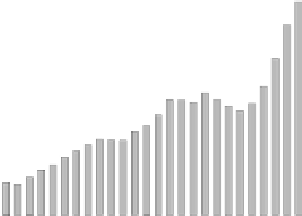Environmental Engineering Reference
In-Depth Information
b) Severe Pollution
Since 2003, the average annual GDP growth rate, calculated at constant prices,
was more than 10%. However, this rapid increase in economy was aided by the
consumption of large amounts of fossil energy and the emission of great amounts
of GHGs, which degraded environmental and ecological systems (Ni 2007). In
2005, China's CO
2
emission from the consumption and flaring of fossil fuels
reached 5322.69 million metric tonnes, sharing 18.9% of the world.
Figure 11.5
il-
lustrates the comparison of the emissions from China and the US, and the propor-
tion of China's emission in the world total.
6,000
20
China
US
18
5,000
16
4,000
14
12
3,000
10
2,000
8
1,000
6
80
85
90
95
00
05
80
85
90
95
00
05
(a)
(b)
Fig.11.5(a).
Carbon Dioxide Emissions (Million Metric tonnes) from the consumption and
flaring of fossil fuels in China and US (1980-2005);
Fig. 11.5(b).
Proportion China's Car-
bon Dioxide Emissions (%) in the world emission (data source: EIA 2008)
China's per capita CO
2
emissions from the consumption and flaring of fossil fuels,
was 4.07 metric tonnes in 2005, lower than the world average of 4.37 metric ton-
nes; and far less than the US per capita emissions of 20.14 metric tonnes,. How-
ever, compared with the emissions of 1.48 metric tonnes in 1980, China's per cap-
ita emission has increased almost 3 times (
Figure 11.6
). Imagine what the world
GHGs emission would be if China's per capita emission was similar to that of the
USA. China signed the Kyoto Protocol in 2002, and is trying its best to reduce its
CO
2
emission (Ni 2007). As a developing country, China's emission per capita
will likely increase further, due to economic development and population. How
can China mitigate its emission greatly?
c) Rural Energy
in 2007, China's rural population was 727.5 million, sharing 55.06% of the total
population (NBSC 2008a). It is a daunting task to supply sustainable and afford-
able energy to 700 million rural residents. More than 10 million rural residents did
not have electricity (NDRC 2007) and a lot of rural residents were still relying on
firewood, stalks and grass (Ni 2007). It was estimated that in 2006 Chinese non-
commercial firewood energy consumption in rural residences was 189.9 million

















































































Search WWH ::

Custom Search